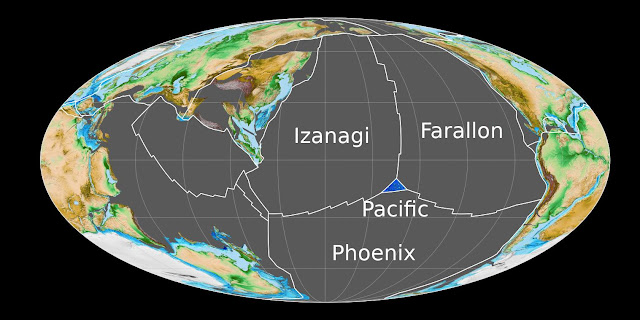イザナギプレートという呼び名は、世界共通です。そもそも日本人が言い出したプレート名ではありません。 イザナギプレートが提唱されたのは、1982年のこの論文だと思います。
Late Cretaceous genesis of the Kula plate
https://www.sciencedirect.com/science/article/pii/0012821X82901911
1982
この論文の要旨の中に、
We propose calling this the Izanagi plate.
と書かれています。 現在の太平洋の地磁気の縞模様を説明するには、中生代には現在見られないプレートが日本付近にあったと考えないと辻褄が合わないと言うことで提唱されたプレートです。
Earth and Planetary Science Letters
Late Cretaceous genesis of the Kula plate
Received 25 August 1981, Revised 10 December 1981, Available online 2 January 2003.
イザナギプレート
イザナギプレート(Izanagi Plate)は、後期白亜紀に存在したプレートの一つ。日本列島の原型を作ったため、日本神話で日本列島を作った神伊弉諾尊に由来した名をつけられた。
1億3千万 - 1億年前に、現在の北西太平洋に相当する地域に存在した。アジア大陸に衝突しながら北東に運動したため多くの横ずれ断層を発生させた。中央構造線もその一つである。現在の中国南部付近にあった島を移動させ、中国北東部に衝突させた。これが日本列島の原型である。西日本の地質(たとえば三波川変成帯)に大きな影響を与え、現在の北海道の中央を縦断していた。
その後イザナギプレートは北西に向かって運動し始め、年に20 - 30 cmという速いスピードでユーラシアプレートの下に沈み込んだ。約2千5百万年前頃には完全に埋没して消滅した。イザナギプレートの消滅後は、北から北米プレート、東から太平洋プレート、南からはフィリピン海プレートがそれぞれ押し寄せている。
関連項目
外部リンク
| ||||||||||||
| Category:プレートテクトニクス/プロジェクト:地球科学/Portal:地球科学 | ||||||||||||
| この項目は、地球科学に関連した書きかけの項目です。この項目を加筆・訂正などしてくださる協力者を求めています(プロジェクト:地球科学/Portal:地球科学)。 |
イザナギプレート
イザナギプレート(神道神イザナギにちなんで名付けられた)は、オホーツクプレート130-100 Ma(百万年前)の下に沈み込み始めた古代の地殻プレートでした。稲城プレートの急速なプレート運動により、北西日本と南西日本の外側のゾーンが北に漂流しました。高圧変成岩は三馬川変成ベルトの漂流陸地の東縁で形成され、低圧変成岩はアブクマ変成ベルトの西縁で形成されました。約95 Maで、イザナギプレートは完全に沈み込み、西太平洋プレートに置き換えられ、北西方向にも沈み込みました。沈み込み関連のマグマティズムは、両家帯の近くで起こった。沈み込みプレートの変更後、アブンクマベルトでは顕著なテクトニクスは発生しませんでした。
北西太平洋での絶滅したジュラ紀・白亜紀の拡散システムの発見は、1972年に絶滅したクラプレートの導入につながった。イザナギプレートはその後、この拡散システムの形状を説明するために1982年に導入されました。[1] 現在サブダクションされたイザナギプレートの知識は、この沈み込みの記録を保存する太平洋プレート上の中生代の磁気系統に限定されています。[2]
参照[編集]
参考文献[編集]
- メモ
- ^ ウッズ&デイヴィス1982、アブストラクト
- ^ シートンら2012年、イザナギプレート、224-2227頁
- ソース
- シートン、M。;ミュラー、R。D.;ザヒロヴィッチ、S.; ゲイナ、c.; Torsvik, T.; Shephard, G.; Talsma, A.; グルニス、M.;マウス、S。;チャンドラー、M。(2012)。「200Ma以降の世界の大陸と海洋盆地の再建」。地球科学のレビュー。113 (3): 212–270。Bibcode:2012ESRv..113..212S. doi:10.1016/j.earscirev.2012.03.002。2016年10月23日取得。
- ウッズ、M。T.;デイヴィス、G.F.(1982)。「クラプレートの白亜紀後期の起源」。地球と惑星科学の手紙.58 (2):161-166。ビブコード:1982E&PSL..58..161W. doi:10.1016/0012-821X(82)90191-1.
Izanagi Plate
This article includes a list of references, related reading, or external links, but its sources remain unclear because it lacks inline citations. Please help to improve this article by introducing more precise citations. (July 2013)(Learn how and when to remove this template message) |

The Izanagi Plate (named after the Shinto god Izanagi) was an ancient tectonic plate, which began subducting beneath the Okhotsk Plate 130–100 Ma (million years ago). The rapid plate motion of the Izanagi Plate caused north-west Japan and the outer zone of south-west Japan to drift northward. High-pressure metamorphic rocks were formed at the eastern margin of the drifting land mass in the Sanbagawa metamorphic belt, while low-pressure metamorphic rocks were formed at its western margin in the Abukuma metamorphic belt. At approximately 95 Ma, the Izanagi Plate was completely subducted and replaced by the western Pacific Plate, which also subducted in the north-western direction. Subduction-related magmatism took place near the Ryoke belt. No marked tectonics occurred in the Abunkuma belt after the change of the subducted plate.
The discovery of an extinct Jurassic–Cretaceous spreading system in the north-west Pacific led to the introduction of the extinct Kula Plate in 1972. The Izanagi Plate was subsequently introduced in 1982 to explain the geometry of this spreading system.[1] Knowledge of the now-subducted Izanagi Plate is limited to Mesozoic magnetic lineations on the Pacific Plate that preserve the record of this subduction.[2]
See also
References
- Notes
- Woods & Davies 1982, Abstract
- Seton et al. 2012, Izanagi Plate, pp. 225–227
- Sources
- Seton, M.; Müller, R. D.; Zahirovic, S.; Gaina, C.; Torsvik, T.; Shephard, G.; Talsma, A.; Gurnis, M.; Maus, S.; Chandler, M. (2012). "Global continental and ocean basin reconstructions since 200Ma". Earth-Science Reviews. 113 (3): 212–270. Bibcode:2012ESRv..113..212S. doi:10.1016/j.earscirev.2012.03.002. Retrieved 23 October 2016.none
- Woods, M. T.; Davies, G. F. (1982). "Late Cretaceous genesis of the Kula plate". Earth and Planetary Science Letters. 58 (2): 161–166. Bibcode:1982E&PSL..58..161W. doi:10.1016/0012-821X(82)90191-1.none
External links
- Geodynamics of Japan
- late Cenomanian – early Campanian (PDF) (not available without registration (free))



























0 件のコメント:
コメントを投稿